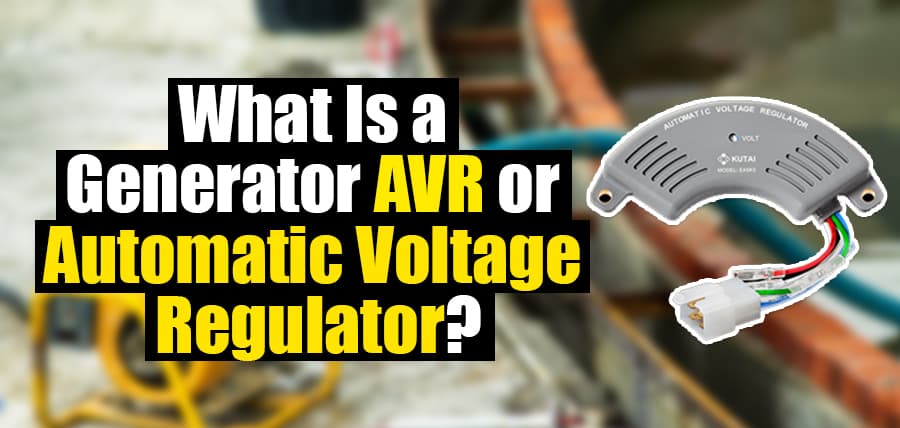If you’re spending time and money to find a reliable generator, at some point, you’ll ask yourself: is the generator going to fry my expensive devices if something goes wrong (i.e., power surge)?
Sadly, nobody can guarantee you that a specific generator will keep your devices safe. Yet some have particular features to prevent power surges from ruining your electronics, such as Automatic Voltage Regulators (AVRs).
The thing is, people don’t really know what Automatic Voltage Regulators are, which leads to a bunch of questions and confusion.
I decided to make this quick article to make things clear regarding Automatic Voltage Regulators in generators. So, let’s get right into it.
What Is a Generator’s AVR or Automatic Voltage Regulator?
I believe that a Generator with an AVR (Automatic Voltage Regulator) is a must if you’re seeking a reliable generator that won’t wreck your expensive electronics.
But what is an Automatic Voltage Regulator? Is it necessary?
I’m gonna answer those questions and more in the next part of the article.
What Does a Generator’s Automatic Voltage Regulator Do?
An automatic voltage regulator, or AVR, is a device integrated with the generator that helps to regulate the voltage delivered.
It has a series of sensors that ensure the generator’s voltage output remains consistent even as the load on the generator changes.
As a result, the AVR automatically adjusts the amount of power generated based on the current demand to make sure your devices are completely safe.
Importance of a Generator’s Automatic Voltage Regulator
Okay, so we know that an automatic voltage regulator on a generator is a device that regulates the voltage delivered to the devices connected to the generator.
Why is this important?
By maintaining a constant voltage output, an AVR can help prevent damage to electrical components, particularly during power surges.
So, if you want to save hundreds or even thousands of dollars, you should look for a generator that includes an AVR.
Where is an AVR Located in a Generator?
The AVR, or automatic voltage regulator, is a critical component in any generator that ensures that all of your devices remain operational even during power outages.
It can be found in the main control box of a non-portable generator or in the alternator’s terminal box. It’s usually found under the alternator’s rear cover on portable generators.
It’s worth noting that keeping the AVR clean and free of debris is critical, as this can affect its performance and, ultimately, put your expensive devices at risk.
Who Offers Portable Generators with Automatic Voltage Regulators?
There are a few brands that offer portable generators with Automatic Voltage Regulators.
These are some examples:
What Happens if a Generator’s AVR Fails?
Well… things will go south pretty quickly.
When your generator’s AVR fails, it will no longer control the voltage output because its sensors will no longer function.
This could endanger your devices, especially during a power surge or if the generator outputs a lower voltage stream, which could also harm your electronics.
Another significant issue is overheating, as when the AVR fails, the rest of the generator’s internal components can quickly heat up.
What can we do to keep this from happening?
Again, clean the AVR of any debris or dirt that could harm the device in the long run.
What Is The Best Generator With an Automatic Voltage Regulator?
Westinghouse iGen4500 Super Quiet Portable Inverter Generator
Westinghouse has become one of my favorite brands for portable generators over the last few decades since it provides dependable, powerful, and reasonably priced products.
The Westinghouse iGen4500 is no exception, as it includes excellent features such as a powerful motor that outputs 3700 rated watts and 4500 peak watts to power your most essential devices.
Additionally, this generator can run for up to 18 hours with a full tank, which is sufficient to power your devices for an entire day.
Although it is only powered by gas, it includes an automatic voltage regulator and provides a clean stream of electricity with less than 3% THD to keep your electronics safe.
Last but not least, it has two very useful features worth mentioning: its remote, electric, and recoil start, and its rotating display, which allows the user to easily read vital information (i.e., voltage, runtime, and power output).
Pros
- 3700 rated watts and 4500 peak watts is enough wattage to power most of your electric devices
- Automatic voltage regulator keeps your expensive devices safe from getting wrecked
- Produces clean energy with less than 3% THD
- Remote start, electric and recoil start for maximum convenience
- Rotating display provides easy-to-read info about voltage, runtime, and power output
- Up to 18 hours of runtime
- EPA and CARB compliant
Cons
- It’s gas only

